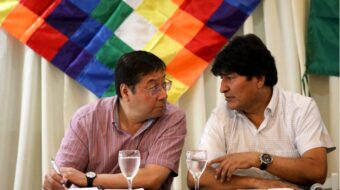
BOYEROS CUBA – Pulling up to the Granma Producers Cooperative Elena Mora and I were warmly greeted by a group of farmers eager to make friends and share the fruits of their hard work. On this blazing hot day, we were ushered into a space sheltered by a traditional thatched roof built by the farmers. They seated us at a long table and proudly piled it with baskets of fruits they had grown – mangos, plantains, guayaba, kimchi, mamei and papaya.
Our visit coincided with national celebrations for the 50th Anniversary of the First Agrarian Reform on May 17, 1959, one of the first acts of the Cuban Revolution. Before the Revolution, 73% of the land was owned by just 9% of landowners, mainly wealthy US investors. Eighteen percent of the best agricultural lands were in the hands of just 15 people. Cuban agriculture produced for export sugar and tobacco and little else. Farmers couldn’t feed their families and starvation was rampant in the countryside.
The reform immediately handed over 1 million hectors of land to 100,000 farmers. Soon the countryside was electrified, everyone learned to read and write, schools, housing and medical clinics were built.
Feeding the people
As we snacked on fruit and sipped coconut juice, the farmers regaled us with stories of the history of the cooperative and how they were tackling difficult challenges today. Our meal was topped off with the savoriest coffee one could imagine grown by cooperative.
“We have 82 farmers here,” explained Imeluis Dominguez Del Rosario, President of the local chapter of the National Association of Small Farmers. “They were individual farmers who teamed up to form a Credit and Service Cooperative (CCS) in 2005. We produce a variety of products like milk, pork meat, fruit, and ornamental plants including the Jose Marti lily. “Our first duty is to feed the Cuban people,” said Del Rosario. She noted that every Cuban receives an adequate amount of nutrition although rationing of basic foods still exists because the restructuring of agriculture is not complete.
The CCS, where farmers own their own land but pool resources with other farmers, is the oldest of three types of producer-based cooperatives that now dominate Cuban agricultural. The Cooperatives of Small Producers (CPA) hold all land and equipment in common. A 3rd Agrarian Reform in 1993 began breaking up many big state farms into small cooperatives called Basic Units of Production and Service (UBPC).
The Granma Cooperative sits on 56 hectors of land once owned by three wealthy families. The cooperative’s oldest farmer and resident historian, Elisio Ramon Mendoza Camejo, recounted how Cuban dictator Fulgencio Batista’s brother had a farm nearby. He held “lavish parties with naked dancers. The farm was surrounded by big fences to keep us out.” Needless to say Batista fled with his brother after the Revolution and the land was taken over during the 1st Agrarian Reform.
“Following the Revolution, the peasants learned to read and write,” said Del Rosario. “They learned history and as a result will never go back to the way things were. We’ll never give up our free health care, education, housing and jobs.” The cooperative signs production contracts with the Ministry of Trade, which in addition to supplying kindergartens, pre-schools and medical clinics sells products to food markets. Farmers get 77% of what is paid to the cooperative. The remainder goes into a common account to improve facilities and machinery. The cooperative meets monthly to make decisions including how to allocate the money.
The 3rd Agrarian Reform in 1993 launched immense changes and occurred in the wake of the collapse of socialism in the Soviet Union and Eastern Europe. They centered on decentralization of production, expansion of arable land, crop diversification and greater use of incentives.
The US imposed blockade had made Cuba dependent on the Soviet Union and the socialist economic community. In exchange for sugar, Cuba received favorable deals for petroleum, chemical fertilizers, pesticides, tractors, other farm implements and spare parts. Cuba also adopted the highly centralized Soviet agricultural model with its large state farms.
When socialism collapsed Cuba lost 85% of its imports overnight. The so-called “Special Period” meant among other things severe food shortages and extreme hardships. Far from being demoralized, the entire country mobilized in response.
Decentralization and organic farming Without the imports Cuban farmers were forced to adopt organic and low-tech methods of production. Farmers drew on a thriving organic farming culture that had existed for years. They eventually replaced tractors with 400,000 oxen and horses and recycled cattle and pig manure into compost that substituted for chemical fertilizer. They instituted crop rotation and natural methods to deal with destructive pests. Everything on the Granma Cooperative is organically grown without a trace of chemicals and part of Cuba’s world-renowned sustainable agriculture system. An international conference examining Cuba’s sustainable agriculture system was being held in Varadero during our visit. Participants included sixteen Americans organized by Global Exchange.
“Our cooperative is part of the nationwide ecological movement. Organic farming minimizes the damages of intensive agriculture. We only produce healthy products and use agricultural technology in balance with the environment,” explained Cooperative President Andres Izquierdo. Each cooperative has an environmental and technical specialist who helps the farmers implement sustainable practices. Scientific and technical forums are held on local, regional and national levels to share the latest developments. A coffee grower at the Granma cooperative developed a method for protecting coffee beans from the destructive Broca pest by simply soaking them in water for a couple of days. He saved 100% of his crop and his technique spread across the country.
Even before the Special Period the Cubans had concluded large-scale centralized production was highly inefficient. The Reform was an opportunity to break up many of the large state farms into cooperatives where decision-making was decentralized and incentives boosted. Crop production was also diversified from a sugar monoculture.
The changes have been immensely effective and production of some crops has begun to return to pre-Special Period levels. Everyone we spoke with told us there will be no going back to the old ways even when the US blockade ends. Earlier that day we met Orlando Lugo Fonte, national president of ANAP. He explained how the agrarian reform was continuing today. The Cuban government has made an urgent priority of overcoming food shortages while they simultaneously become more self-sufficient in response to rapidly rising prices on the global food market.
“Every available plot of land is sought out for cultivation. Over one million hectors of fallow state owned land have been opened for cultivation in the last few years and over 150,000 people have decided to try life on the farm,” said Fonte.
Since the start of the Special Period urban agriculture has become a huge source of fruits and vegetables. By 2006 urban farms were producing 4.2 million tons of food and employing 354,000 people. Over 5,000 once polluted sites have been turned into gardens.
Incentives and socialism
Fonte said more incentives are being employed to boost production. Once some of the nation’s lowest paid workers, farmers are now considered a strategic sector and prices they are paid for agricultural products have been raised to bolster incomes.
We asked our Granma friends if they ever had a problem with a lazy farmer. They laughed and said such a farmer would be kicked out of the cooperative. But then they turned serious and replied everyone had an incentive to produce for their families and themselves and working hard wasn’t a problem. They have an individual and collective incentive to profit.
The government has transferred the vast distributive network responsible for buying 90% of agricultural products from cooperatives and farms from the Agricultural Ministry to the domestic Ministry of Trade. The number of state produce markets where farmers can sell their products is being doubled.
The food needs of Cuba are vast and present a ready market for US farmers and agri-business corporations. Surprisingly, Cuba’s largest supplier of food and agricultural products is the US where it gets 70% of its corn and 40% of its wheat. When the restrictive blockade falls, Cuban imports should rise dramatically. For example Cuba gets the bulk of its rice all the way from Vietnam instead of nearby Arkansas.
One can’t help but be inspired with how the Cuban people have faced every adversity and turned negatives into positives along the way. With their collective can-do spirit it seems there’s no problem they can’t conquer and no dream they can’t harvest.










